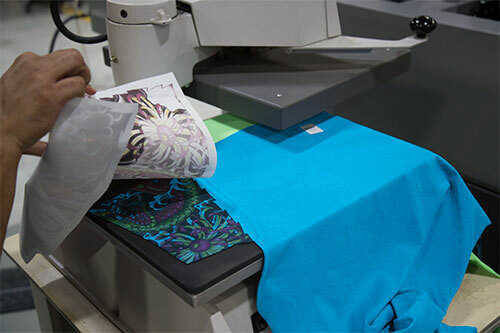Why DTF Printing is the Future of Customized Apparel Production
Technologies in DTF Printing: How It's Reinventing the Sector
The textile printing sector is undertaking a considerable improvement, driven by the cutting-edge innovations in Direct-to-Film (DTF) modern technology. With exceptional ink formulas, improved movie and adhesive technologies, and the assimilation of automation, DTF printing uses lively, resilient prints on a range of textiles, satisfying the increasing need for personalization.
Developments in DTF Technology
Advancing swiftly, DTF (Direct-to-Film) printing innovation has actually undergone considerable renovations that are reinventing the fabric sector. Modern DTF printers utilize innovative ink formulations that result in vibrant, long lasting prints with high resolution and shade accuracy.

Furthermore, developments in movie and glue modern technologies have improved the overall application process. New films provide much better elasticity and adhesion, improving the longevity and washability of the published layouts - sublimation printing. This makes sure that the prints maintain their stability and vibrancy even after several washes
Lastly, environmental factors to consider have actually triggered the advancement of green DTF remedies. Suppliers are progressively embracing sustainable practices, such as using water-based inks and recyclable films, straightening with global efforts to lower the sector's environmental footprint.
Benefits Over Conventional Techniques
When comparing DTF printing to traditional methods such as display printing and direct-to-garment (DTG) printing, a number of unique advantages arise. sublimation printing. One of one of the most substantial advantages is its convenience in material compatibility. Unlike screen printing, which often calls for particular textile types, DTF printing can be used to a wider variety of materials, including cotton, polyester, and blends, without jeopardizing print high quality
One more significant advantage is cost-effectiveness, especially for little to medium-sized orders. Conventional display printing ends up being economically feasible only at greater volumes as a result of the configuration prices included. In comparison, DTF printing gets rid of these setup costs, making it more economical for smaller sized batches and one-off layouts.
Additionally, DTF printing masters sturdiness and washability. The prints produced are robust and keep their stability via several clean cycles, exceeding DTG prints that might fade or split with time. Additionally, DTF printing uses faster turn-around times. Without the demand for substantial setup, layouts can be printed and transferred in a portion of the moment required for screen printing.

Enhanced Layout Abilities
DTF printing uses enhanced style capabilities that set it apart from standard printing techniques. The process involves publishing a style onto a special film, which is after that moved to material.
Furthermore, DTF printing supports a wide array of textiles, consisting of cotton, polyester, blends, and even non-textile substrates. This versatility opens up doors for innovative applications in diverse markets such as fashion, home style, and advertising products. Unlike screen printing, which can be limiting due to color separation and stencil production, DTF printing streamlines the process, making photo-realistic and multi-color styles much more available.
Additionally, DTF printing excels in accomplishing regular shade accuracy and vibrancy. In essence, DTF printing equips developers to push the boundaries of imagination, providing aesthetically magnificent outcomes that were previously unattainable.
Cost and Time Effectiveness
One of the remarkable benefits of DTF printing exists in its price and time effectiveness, making it a preferred choice for many organizations. Unlike typical approaches that need significant financial investment in displays and configuration times, DTF printing allows for straight application onto different materials with minimal prep work.
Additionally, DTF printing excels in producing brief runs and personalized orders cost-effectively. The capacity to create top notch see prints without the requirement for large quantity commitments reduces waste and optimizes resource appropriation. This flexibility is particularly useful for tiny organizations and start-ups that may not have the resources to purchase large production runs.
In terms of functional performance, DTF printing's streamlined process boosts total productivity. Thus, DTF printing stands out as a transformative option in the printing market.
Future Trends in DTF Printing
Preparing for future trends in DTF printing reveals a landscape marked by fast technological innovations and boosted market need (sublimation printing). One substantial fad is the assimilation of expert system (AI) and artificial intelligence algorithms to optimize print quality and streamline procedures. AI-driven systems can anticipate prospective problems and change setups in real-time, making sure constantly high-grade result
In addition, innovations in lasting products and green inks are expected to gain grip. As ecological worries end up being much more pressing, the market is likely to see a shift in the direction of non-toxic and eco-friendly inks, decreasing its environmental footprint.
Modification and customization will also play a crucial duty. With the growing consumer need for special, personalized items, DTF printing innovations are developing to use more thorough and detailed personalization choices. This trend is sustained by improved software remedies that permit even more complex and imaginative styles.
Lastly, the assimilation of DTF printing with other electronic platforms and e-commerce remedies will come to be more smooth. This connectivity will make find out here it possible for businesses to supply on-demand printing services straight to consumers, additionally driving growth in the industry. These patterns jointly highlight a future where DTF printing not only fulfills however goes beyond the advancing needs of the market.
Verdict

When contrasting DTF printing to look at this web-site traditional approaches such as screen printing and direct-to-garment (DTG) printing, a number of distinctive benefits arise. Unlike screen printing, which frequently calls for particular textile types, DTF printing can be used to a broader array of materials, consisting of cotton, polyester, and blends, without compromising print high quality.
DTF printing supplies boosted layout abilities that establish it apart from conventional printing techniques. Thus, DTF printing stands out as a transformative service in the printing sector.
Developments in DTF printing dramatically enhance the fabric printing sector by providing remarkable print performance, versatility, and quality.